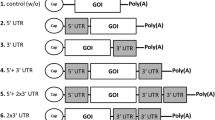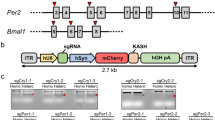Abstract
To investigate the effect of two deoxyribozymes targetingperiod1 (per1) mRNAin vitro for exploring a novel gene therapy approach about circadian rhythm diseases, the specific deoxyribozymes targetingper1 were designed and synthesized chemically following MFold analysis according to its mRNA secondary structure.per1 RNA fragments were prepared byin vitro transcription of pcDNA3.1(+)-per1 164:256. The cleavage reactions containing deoxyribozymes andper1 RNA fragments were performed under certain conditions. With the transfection technique mediated by Lipofect AMINE™, pcDNA3-per1 and DRz164 or DRz256 were introduced into NIH3T3 cells. The effects of deoxyribozymes onper1 were studied by reverse transcript-polymerase chain reaction (RT-PCR) and flow cytometry (FCM). When deoxyribozymes and RNA transcripts were incubated under the adopted conditions at 37°C for 2 h, about 63% ofper1 164:256 RNA transcripts were cleaved by DRz164 and about 50.5% by DRz256. After cotransfecting pcDNA3-per1 with DRz164 or DRz256, the expression ofper1 mRNA was decreased, as indicated by RT-PCR semi-quantity analysis. FCM analysis showed that Per1 protein was inhibited. Both DRz164 and DRz256 targetingper1 have the specific cleavage activity towardper1 mRNAin vitro and can highly block the expression ofper1 gene in cellular milieu.
Similar content being viewed by others
References
Devlin, P. F., Kay, S. A., Circadian photoperception, Annu. Rev. Physiol., 2001, 63: 674–694.
Konopka, R. J., Benzer, S., Clock mutants ofDrosophila melanogaster, Proc. Natl. Acad. Sci. USA, 1971, 68: 2112–2116.
Dunlap, J. C., Molecular bases for circadian clocks, Cell, 1999, 96: 271–290.
Giorgetti, M., Zhdanova, I. V., Chronic cocaine treatment induces dysregulation in the circadian pattern of rats’ feeding behavior, Brain Research, 2000, 877: 170–175.
Iijima, Y., Shinoda, M., Kuribara, H. et al., Evaluation of acute and sub-acute effects of cocaine by means of circadian variation in wheel-running and drinking in mice, Nihon Shinkei Seishin Yakurigaku Zasshi, 1995, 15: 315–321.
Kita, T., Takahashi, M., Wagner, G. C. et al., Methamphetamine-induced changes in activity and water intake during light and dark cycles in rats, Prog. Neuropsychopharmacol. Biol. Psychiatry, 1998, 22: 185–1196
Robinson, T. E., Berridge, K. C., The neural basis of drug craving: An incentive-sensitization theory of addiction, Brain Res. Rev., 1993, 18: 247–291.
Strakowski, S. M., Sax, K. W., Setters, M. J., Enhanced response to repeated d-amphetamine challenge: Evidence for behavioral sensitization in humans, Biol. Psychiatry, 1996, 40: 872–880.
Andretic, R., Chaney, S., Hirsh, J., Requirement of circadian genes for cocaine sensitization inDrosophila, Science, 1999, 285: 1066–1068.
Nikaido, T., Akiyma, M., Moriya, T. et al., Sensitized increase of period gene expression in the mouse caudate/putamen caused by repeated injection of methamphetamine, Mol. Pharmacol., 2001, 59: 894–900.
Abarca, C., Albrecht, U., Spanagel, R., Cocaine sensitization and reward are under the influence of circadian genes and rhythm, Proc. Natl. Acad. Sci. USA, 2002, 99: 9026–9030.
Andretic, R., Hirsh, J., Circadian modulation of dopamine receptor responsiveness inDrosophila melanogaster., Proc. Natl. Acad. Sci. USA, 2000, 97: 1873–1878.
Penas, E. M., Cools, J., Algenstaedt, P. et al., A novel cryptic translocation t[12;17][p13;p12–p13] in a secondary acute myeloid leukemia results in a fusion of theETV6 gene and the antisense strand of thePER1gene, Genes Chromosomes Cancer, 2003, 37(1): 79–83.
Santoro, S. W., Joyce, G. F., A general purpose RNA-cleaving DNA enzyme, Proc. Natl. Acad. Sci. USA, 1997, 94: 4262–4266.
Khachigian, L. M., DNAzymes: Cutting a path to a new class of therapeutics, Curr. Opin. Mol. Ther., 2002, 4: 119–121.
Zuker, M., On finding all suboptimal folding of an RNA molecule, Science, 1989, 244: 48–52.
Breaker, R. R., Joyce, G. F., A DNA enzyme with Mg2+-dependent RNA phosphoesterase activity, Chem. Biol., 1995, 2: 655–600.
Zhang, L., Gasper, W. J., Stass, S. A. et al., Angiogenic inhibition mediated by a DNAzyme that targets vascular endothelial growth factor receptor 2, Cancer Research, 2002, 62: 5463–5469.
Goodchild, J., Hammerhead ribozymes: Biochemical and chemical considerations, Curr. Opin. Mol. Ther., 2000, 2: 272–281.
Santiago, F. S., Lowe, H. C., Kavurma, M. M. et al., New DNA enzyme targeting Egr-1 mRNA inhibits vascular smooth muscle proliferation and regrowth factor injury, Nature Med., 1999, 5: 1264–1269.
Wu, Y., Yu, L., McMahon, R. et al., Inhibition of bcr-abl oncogene expression by novel deoxyribozymes (DNAzymes), Hum. Gene Ther., 1999, 10: 2847–2857.
Yen, L., Strittmatter, S. M., Kalb, R. G., Sequence-specific cleavage of Huntingtin mRNA by catalytic DNA, Ann. Neurol., 1999, 46: 366–373.
Author information
Authors and Affiliations
Corresponding author
Rights and permissions
About this article
Cite this article
Zhou, W., Wang, Y., Liu, Y. et al. Deoxyribozymes inhibit the expression ofperiod1 genein vitro . Sci. China Ser. C.-Life Sci. 48, 195–201 (2005). https://doi.org/10.1007/BF03183612
Received:
Revised:
Issue Date:
DOI: https://doi.org/10.1007/BF03183612




